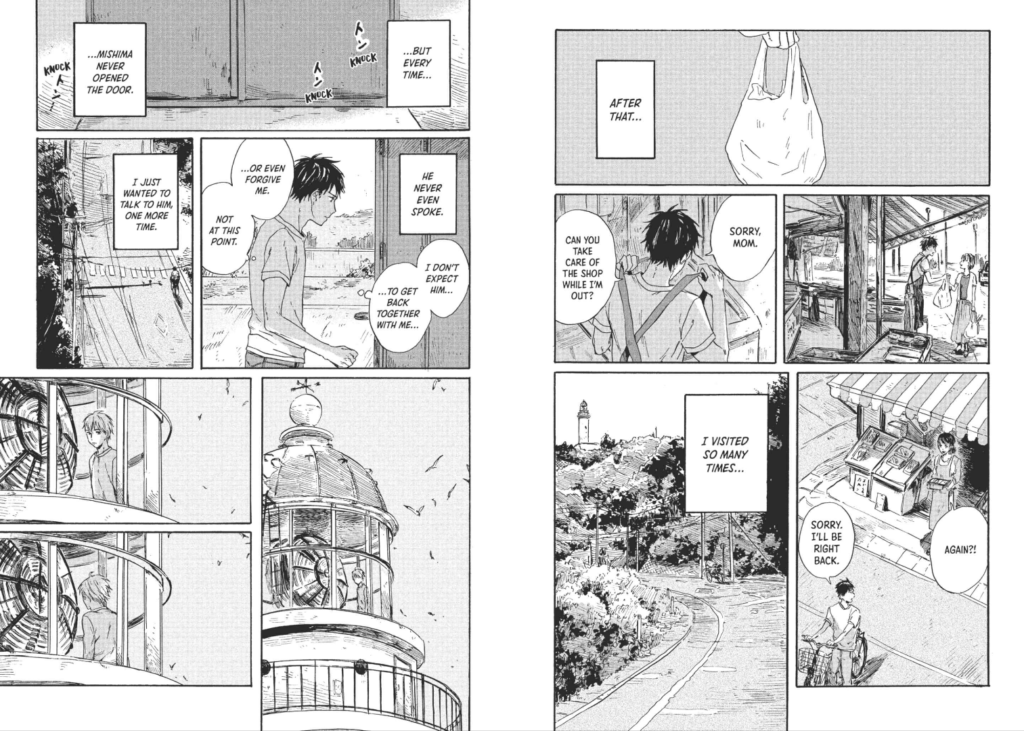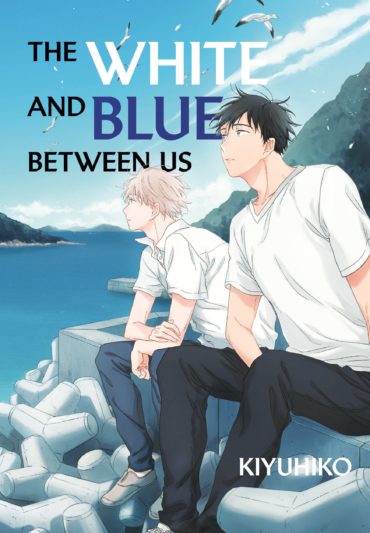The White and Blue Between Us Review
I didn’t want to hurt him. I just wanted him to hate me. Well… At least, that’s what I tell myself. Hozumi, thinking about Mishima.
Hozumi and Mishima started dating in high school. But after graduation, Hozumi had to leave their island home to attend college and so he told Mishima that he didn’t love him. When, seven years later, Hozumi returns to help in the family business (fishing and fish shop), he goes to a high school reunion. But if he’d hoped to see Mishima, he’s disappointed. His friends tell him that Mishima has become reclusive (“a shut-in”), inheriting the role of lighthouse keeper from his grandfather and spending all his time at the lighthouse. Hozumi is eager to heal the rift that he created and to confess that he lied about his feelings – but when he goes to the lighthouse, Mishima – not surprisingly – wants nothing to do with him. In fact, he refuses to talk to him, ignoring his pleas. Hozumi stubbornly refuses to accept defeat, returning again and again, without success. Until one day, the rain sets in while Hozumi is waiting outside the lighthouse… and Mishima relents, bringing him inside to dry off and wait until the rain stops. But he’s in no way ready for any kind of reconciliation and tells Hozumi in no uncertain terms to stop coming to the lighthouse. Hozumi’s going to have to find another way to persuade Mishima to listen to what he wants to say – and it’s not going to be easy.
So why after all this time did he turn up again? He’s forced me to relive that memory. The memory of the spring after graduation… when I watched him sail far, far away. Mishima, thinking about Hozumi.

The White and Blue Between Us © Kiyuhiko/Kodansha Ltd.
With The White and Blue Between Us Kodansha brings us the first of Kiyuhiko’s Boys’ Love manga to be published in English and it’s always good to be able to discover a new mangaka. The narrative goes back and forth between the past and the present, changing viewpoints so that in Chapter 2 we get to see how Mishima feels about Hozumi and why he reacts so dramatically to his sudden return after so many years away. However, it’s worth noting that the main narrative reaches a resolution relatively early on and is followed by a substantial bonus chapter which goes back to show the two in high school and provides much of the background to their relationship, which helps to flesh it out. Coming as it does, so late in the scheme of events, this isn’t entirely successful. Although if the mangaka had put it at the beginning of the story, it might have unbalanced the way she decided to hit the ground running by presenting us with Hozumi’s return to the island after the seven-year gap. And perhaps that’s one of the reasons why there’s something of a strangely muted feel about the central relationship. We don’t ‘know’ enough about these two young men and so it’s a little difficult to get too involved in their relationship, even though it’s sympathetically portrayed.
Nevertheless, one of the strengths of this story is in depicting the way Hozumi eventually comes out to his family. It’s refreshing to find another Boys’ Love slice-of-life manga in which there are no great dramas and Hozumi’s mother and big brother are shown as being sympathetic and supportive.
The publisher’s blurb suggests that The White and the Blue Between Us will appeal to fans of Nagisa Furuya’s My Summer of You (that blue cover art!), Rihito Takarai’s Seven Days, or Yuki Fumino’s I Hear the Sunspot. While I see what they’re getting at in making these comparisons (all three titles start in high school and deal mostly with feelings, rather than portraying the sexual side of first relationships), Kiyuhiko doesn’t shy away from showing us that aspect – hence the Mature 18+ rating. Not that there’s anything too explicit here, it’s relatively discreetly drawn but nevertheless, the book comes shrink-wrapped.
The translation is by Leo McDonagh and works well; there’s a page with three helpful translation notes at the end, as well as a ‘thank you page’ by the mangaka. The lettering is expertly done by Nicole Roderick and Kodansha have included an attractive colour illustration (more ‘white and blue’) at the front.
However, it’s Kiyuhiko’s drawings of the island, especially the lighthouse that plays such a significant role in the young men’s lives, that are so effective in giving this one-shot its unique marine atmosphere.
Our review copy from Kodansha was supplied by Diamond Book Distributors UK.
Read the first chapter for free at the publisher’s website here.


